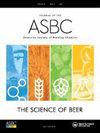Study on the Composition of Hop Terpenes and Terpenoids by Steam Distillation and Effects on Beer Flavor by an Ale Yeast
IF 1.8
4区 农林科学
Q4 BIOTECHNOLOGY & APPLIED MICROBIOLOGY
Journal of the American Society of Brewing Chemists
Pub Date : 2022-09-30
DOI:10.1080/03610470.2022.2111948
引用次数: 0
Abstract
Abstract Model systems of adding three distillates (hop oil, water-soluble aqueous, and residual aqueous) in model wort (buffer) and wort were used to produce model beers and special beers, respectively (with an ale yeast and fermentation at 18 °C). The attributes of hoppy flavor and organoleptic quality were comprised of sustained, surged, generated, or diminished oxygenated compounds and hydrocarbons by yeast biosynthesis in hop essential oil and non-volatile precursors. The matrix of content and instrumental composition of oxygenated terpenoids and hydrocarbons (terpenes and sesquiterpenes) and sensorial profile of model systems was directionally correlated to the matrix and sensory of the early hopped, late hopped, and dry hopped beers. The occurrence of hop aroma profile of the residual aqueous is reminiscent to traditional early kettle hopped beer. The water-soluble volatile components added beer were remarkably close to the distinctive odor profile of late hopped beer. However, dry hopped beer was seemingly a coupling of the hop oil and the water soluble aqueous added beers, but its perception was closer to the latter. The mechanism of the growth of nerol, citronellol, and methyl geranate via a reversed biosynthesis of free linalool by ale yeast and fermentation at 18 °C is contrary to a pathway via geraniol from the hop oil or the water-soluble aqueous. Free linalool was sustained after yeast hydrolysis of linalyl glycoside and related to metabolites in the residual aqueous due to sluggish yeast activity in the model wort (buffer) but not in the wort.蒸汽蒸馏法研究啤酒花萜烯和萜类成分及其对啤酒风味的影响
在模型麦汁(缓冲液)和麦汁中添加三种馏分物(啤酒花油、水溶性水和残余水)的模型体系分别用于生产模型啤酒和特殊啤酒(用啤酒酵母和18°C发酵)。啤酒花香精和非挥发性前体通过酵母生物合成持续、激增、生成或减少的含氧化合物和碳氢化合物组成啤酒花风味和感官品质的属性。含氧萜类化合物和碳氢化合物(萜烯和倍半萜烯)的含量和仪器组成矩阵以及模型系统的感官特征与早、晚、干三种啤酒的矩阵和感官特征有方向性相关。残水啤酒花香气的出现让人联想到传统的早期水壶啤酒花。添加的水溶性挥发性成分与后期啤酒花啤酒的独特气味特征非常接近。然而,干啤酒花啤酒似乎是啤酒花油和水溶性水添加啤酒的结合,但它的感觉更接近后者。通过啤酒酵母在18°C下逆向生物合成游离芳樟醇和发酵来生长橙醇、香茅醇和老香酸甲酯的机制与通过啤酒花油或水溶性水来生长香叶醇的途径相反。酵母水解芳樟苷后,游离芳樟醇持续存在,并且与残留水中的代谢物有关,因为酵母活性在模型麦汁(缓冲液)中缓慢,而在麦汁中没有。
本文章由计算机程序翻译,如有差异,请以英文原文为准。
求助全文
约1分钟内获得全文
求助全文
来源期刊

Journal of the American Society of Brewing Chemists
工程技术-生物工程与应用微生物
CiteScore
4.00
自引率
20.00%
发文量
41
审稿时长
3 months
期刊介绍:
The Journal of the American Society of Brewing Chemists publishes scientific papers, review articles, and technical reports pertaining to the chemistry, microbiology, and technology of brewing and distilling, as well as the analytical techniques used in the malting, brewing, and distilling industries.
 求助内容:
求助内容: 应助结果提醒方式:
应助结果提醒方式:


